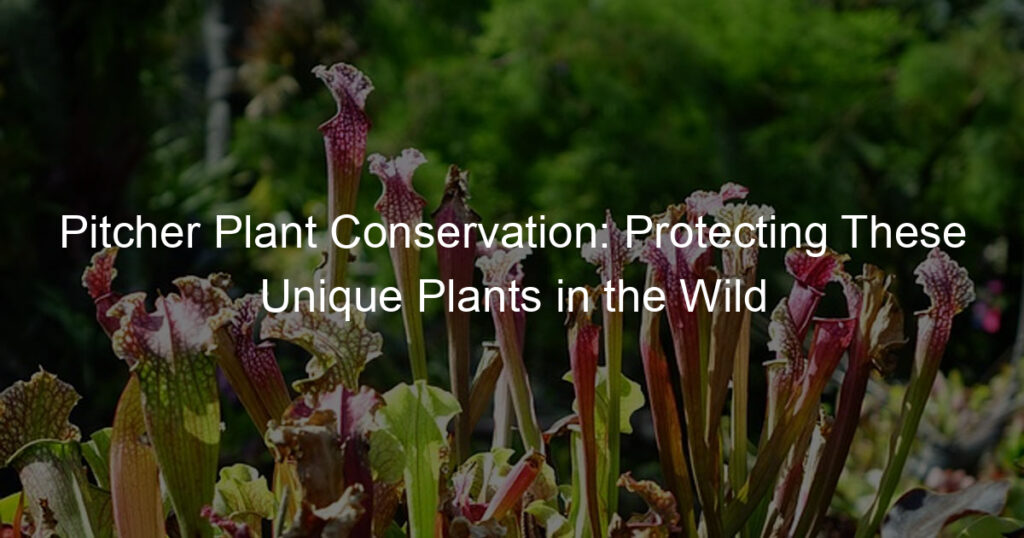If you’ve ever been to a wetland or area with swamps, then you know the beauty and mystique of pitcher plants. These carnivorous flowerlike plants are not only impressive — they’re also important parts of their natural ecosystems. Unfortunately, though, many Pitcher Plants have become endangered in some areas due to environmental factors, and conservation has become increasingly vital to preserving them in their natural habitats.
Why are pitcher plants endangered?
Pitcher plants are generally considered iconic plant species, usually seen in tropical environments. Unfortunately, these plants are endangered due to human activities that show a disregard for the environment, such as deforestation and industrial pollution.
Deforestation or habitat destruction reduces the amount of available space for pitcher plants to thrive and reproduce, while industrial pollution can be toxic to the delicate environment that pitcher plants need to grow and survive. Furthermore, unsustainable harvesting methods have put pressure on pitcher plant populations across the world by introducing further risks such as a decrease in genetic diversity.
The spread of disease and an overall decrease in numbers. All these factors combined create difficult odds for breeding programs that attempt to enhance the growth rate of these endangered plant species so they may persist into future generations.
What is being done to conserve pitcher plants?
Pitcher plants are some of the most unique carnivorous plants in the world, and thankfully people are actively looking for ways to conserve this wonderfully weird species.
Conservationists around have implemented some specific strategies such as putting restrictions on pitcher plant harvesting and restricting areas where a pitcher plant population is declining.
Additionally, organizations have built management plans that plan out how to cope with potential threats against pitcher plants, while also taking into account the needs of local communities. Finally, research is being conducted to better understand the populations and dynamics of these fascinating plants so conservation efforts will be well-informed and effective.
How can we protect pitcher plant habitats?
Protecting pitcher plant habitats is an important goal if we wish to ensure their continued survival. Effectively protecting their environment requires understanding their needs, like moisture and sunlight levels, and taking steps to preserve those natural conditions in their habitat.
Moreover, limiting human activity near pitcher plants is essential for reducing the risk of disturbances and destruction. That could mean creating buffer zones around high-risk areas or limiting road construction projects in those locations.
For example, recreational activities should be limited due to the noise produced which disturbs the environment that pitcher plants live in. Ultimately, preserving the necessary conditions in which pitcher plants thrive will help keep them safe and healthy while still allowing space for people to enjoy nature responsibly.
What laws protect pitcher plants?
Pitcher plants are incredible and unique organisms, but their survival is far from guaranteed. To ensure we keep these amazing living creatures around for the future, many countries have enacted laws specifically protecting them from overexploitation.
In the United States, the Endangered Species Act of 1973 prevents any pitcher plant species from being taken or harmed without a permit. Likewise in Canada, the Wild Animal and Plant Protection and Regulation of International and Interprovincial Trade Act protects several pitcher plant species.
Even more strict protections can be found on a local level as well. For example, some states have even made it illegal to transport wild carnivorous plants like pitcher plants from place to place. Thankfully, with all these protective laws in place, the chance of encountering a pitcher plant in nature isn’t just possible – it’s likely!
What are the biggest threats to pitcher plants?
Pitcher plants are one of the marvels of nature. Found in boggy, wet areas, these carnivorous plants have evolved to dig their roots deep and use their pitchers – modified leaves that attract, trap, and digest small insects – as a source of nutrients.
However, it’s these same traits that make pitcher plants certain threats. From environmental degradation due to climate change and acid rain to deforestation, these threats can put some species of pitcher plants at risk for extinction.
Additionally, illegal poaching for commercial reasons has become a real danger for this incredible plant, as have excessive tourism sites that can damage the natural homes of these delicate flowers. We must remain vigilant to protect them and ensure they remain part of our world long into the future.
How can individuals help conserve pitcher plants?
One of the best ways individuals can help conserve pitcher plants is by growing them in their gardens or terrariums and using organic fertilizer that helps to prevent further damage to the environment.
Individuals should also be mindful when visiting natural habitats as pitcher plant populations have declined due to overharvesting from recreational activities such as picking, digging, and trampling. Also, research should be done before purchasing exotic species for home cultivation or personal collections to make sure the plants are acquired through legal means.
Most importantly, individuals should spread awareness about these rare and endangered species however they can – whether that’s sharing knowledge with friends and family, creating online content dedicated to their conservation, or donating resources directly to organizations that devote time and energy toward their protection.
Conclusion
By preserving these plants, we can ensure that generations to come will be able to experience the beauty and uniqueness of the pitcher plant. From their intricate shapes to their unusual digestive system, pitcher plants are an intriguing species that deserve our attention and respect. We must put forth our best effort in protecting these endangered species, so that they may remain for years to come. Additionally, raising awareness about pitcher plants is key in terms of conservation and habit preservation efforts.








